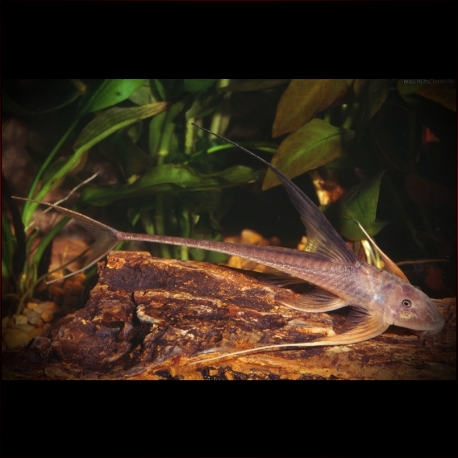More info
Datasheet
| Minimum Tank Size | 270 litres / 71.33 US gallons |
| Maximum Size | 16.7cm / 6.57inches |
| Temperature | 22°C / 71.60°F - 30°C / 86.00°F |
| Hardness | 2.02dgH / 36ppm - 15.02dgH / 268ppm |
| pH | 5.5-7.5 |
General DescriptionThe Sturgeon Catfish, scientifically known as Lamontichthys Filamentosus, is a species within the Loricariidae family of the Siluriformes order. This fish is easily recognized by an extended pectoral-fin spine that forms an exceptionally long filament in larger specimens, a unique characteristic among its congeners. Its distinct features also include a filamentous extension on the dorsal-fin spine and a semicircular lower lip.
Aquarium SetupTo keep the Sturgeon Catfish healthy, a mature aquarium with ample algae-covered rocks and surfaces is necessary. The recommended tank size is a minimum of 270 liters, with clean, well-oxygenated water. The substrate can be gravel, sand, or a combination, complemented by water-worn rocks and pebbles. Aged driftwood is suitable, but new pieces should be avoided due to potential tannin leaching. Strong lighting is crucial for algae growth, and adaptable aquatic plants like Microsorum, Crinum, and Anubias species can be added for cover and food source.
BehaviourThis species thrives in stable water conditions and feeds predominantly on biofilm and benthic algae. Sturgeon Catfish are peaceful and suitable for community tanks with non-aggressive tankmates. They are primarily active during the night, displaying secretive behavior during the day.
Feeding and DietIn their natural habitat, Sturgeon Catfish consume benthic algae and associated microorganisms by rasping solid surfaces. In captivity, they readily accept high-quality dried foods, live or frozen bloodworms, and homemade gelatin-bound foods rich in fresh vegetables. Excessive protein in their diet can lead to internal issues, emphasizing the importance of providing a balanced food variety.
Reproduction & DimorphismDetails on the specific reproductive behaviors and dimorphic characteristics of Lamontichthys Filamentosus are not provided in the available information.
Habitat and DistributionThe Sturgeon Catfish is native to the central and western Amazon basins, inhabiting regions of Brazil, Peru, Ecuador, and Bolivia. The species' type locality is near the mouth of the Rio Embira, a tributary of the Rio Tarauaca, itself flowing into the Rio Jurua.

